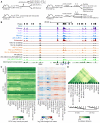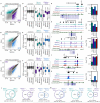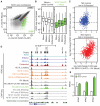Dynamic Changes in Chromatin Accessibility Occur in CD8+ T Cells Responding to Viral Infection
- PMID: 27939672
- PMCID: PMC5214519
- DOI: 10.1016/j.immuni.2016.10.028
Dynamic Changes in Chromatin Accessibility Occur in CD8+ T Cells Responding to Viral Infection
Abstract
In response to acute infection, naive CD8+ T cells expand, differentiate into effector cells, and then contract to a long-lived pool of memory cells after pathogen clearance. During chronic infections or in tumors, CD8+ T cells acquire an "exhausted" phenotype. Here we present genome-wide comparisons of chromatin accessibility and gene expression from endogenous CD8+ T cells responding to acute and chronic viral infection using ATAC-seq and RNA-seq techniques. Acquisition of effector, memory, or exhausted phenotypes was associated with stable changes in chromatin accessibility away from the naive T cell state. Regions differentially accessible between functional subsets in vivo were enriched for binding sites of transcription factors known to regulate these subsets, including E2A, BATF, IRF4, T-bet, and TCF1. Exhaustion-specific accessible regions were enriched for consensus binding sites for NFAT and Nr4a family members, indicating that chronic stimulation confers a unique accessibility profile on exhausted cells.
Copyright © 2016 Elsevier Inc. All rights reserved.
Figures






References
-
- Barber DL, Wherry EJ, Masopust D, Zhu B, Allison JP, Sharpe AH, Freeman GJ, Ahmed R. Restoring function in exhausted CD8 T cells during chronic viral infection. Nature. 2006;439:682–687. - PubMed
Publication types
MeSH terms
Substances
Grants and funding
LinkOut - more resources
Full Text Sources
Other Literature Sources
Molecular Biology Databases
Research Materials

